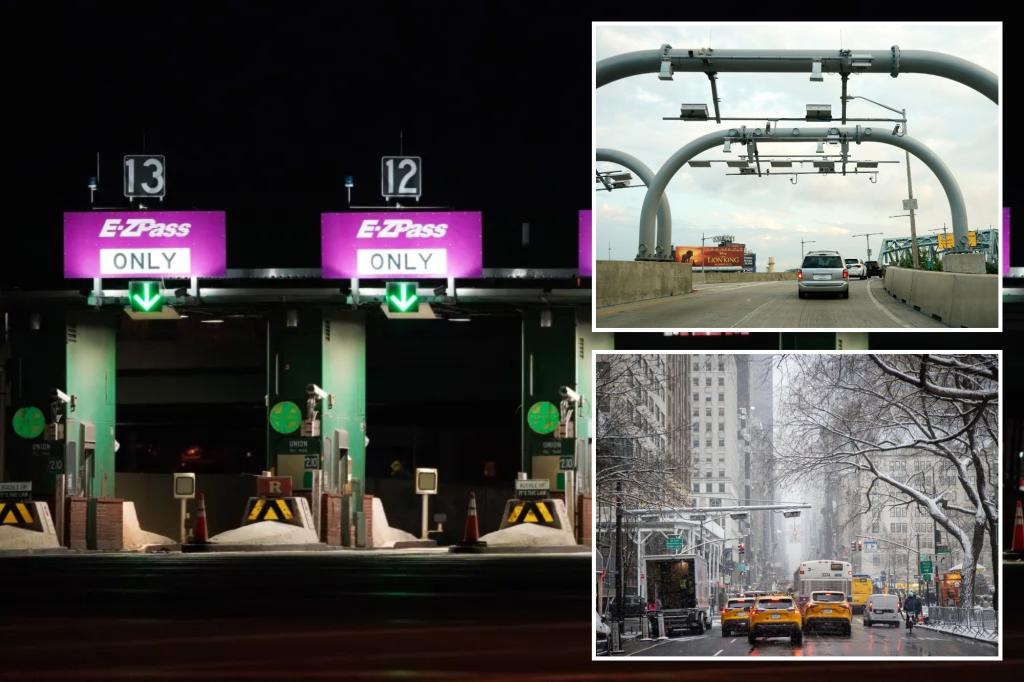Deadbeat drivers racked up $5.1 billion in unpaid MTA tolls and violations over four years – a number likely sent skyrocketing since “cashless” systems replaced the old payment booths, records reveal.
The flailing Metropolitan Transportation Authority estimated total uncollected “toll violations” at more than $1.4 billion in 2024 alone and $3.7 billion combined from 2021 through 2023, according to a financial chart included in a request for proposals submitted to potential debt collectors.
And the annual loss in toll revenues could eventually surpass $2 billion in upcoming years when including non-payment of tolls for the new $9 congestion pricing toll to enter Manhattan south of 60th Street, the document projected.
“Instead of hitting people with a new and very unfair toll, the MTA should have focused its efforts to get deadbeats to pay existing tolls all along,” said Rep. Nicole Malliotakis (R-Staten Island/Brooklyn), who is urging President Trump to kill congestion pricing.
“The real problem is Governor Kathy Hochul and the Democrat-controlled state legislature have created an environment where people feel they don’t need to follow the rules because there are zero consequences. Enforce toll and fare beating and punish egregious repeat offenders not honest hard-working commuters.”
The newly surfaced estimate for toll cheating is much larger than what the MTA has indicated in prior public statements. It’s reported that fare and toll evasion combined costs the mega-transit agency $700 million to $800 million a year — and that’s mostly attributed to subway and bus fare cheating rather than toll cheats.
Rep. Mike Lawler, the lower Hudson Valley Republican who is mulling a run for governor, called the apparent loss of toll revenue “really pathetic.”
“Between fare jumpers and toll beaters, the MTA is losing a staggering $2 Billion per year. This level of gross negligence is criminal, plain and simple,” Lawler said.
“The MTA needs an immediate forensic audit and a complete purge of its incompetent management team starting with John Lieber,” he added, referring to the MTA chairman and CEO.
The MTA has admitted it is having difficulty getting toll deadbeats to pay up after toll booths were eliminated in 2017 for open road “cashless” tolling. The toll booths for cash lanes had gates that barred passage without paying.
More than 90% of drivers use E-ZPass and the tolls are debited from their account. If they don’t pay, the MTA can shut down their accounts.
But the overwhelming majority of scofflaws do not have E-ZPass, according to the data. The agency’s readers photograph the license plates of those who don’t pay the toll electronically with an E-ZPass account.
These drivers are billed by mail, and therefore the debt is harder to collect.
“About 49% of the billed amounts go unpaid, pending further action such as referral to collection,” the MTA said in a report on fare and toll evasion in 2023.
However, the MTA does not classify “failure to pay a bill as “evasion,” as it does as it does for license plate fraud.
MTA toll crossings include the Hugh Carey/Brooklyn Battery Tunnel, Queens Midtown Tunnel, Whitestone Bridge, Throgs Neck Bridge, Verrazano-Narrows Bridge, Cross Bay Bridge, Marine Parkway Bridge, Henry Budget Bridge, Robert Kennedy-Triboro Bridge.
The MTA didn’t respond to numerous Post inquiries about the gigantic toll cheating cited in its own document sent to debt collection firms.
But a source familiar with the bidding process said the numbers are the numbers — and billions of dollars in toll debt was discussed with collection agencies.
The loss of revenues to toll beaters is so massive that it’s “too much for any” one firm to handle, though the MTA plans to contract with one company, the source said.
Collecting outstanding tolls is a tall task, according to the MTA’s Jan. 17 Q&A session with potential bidders.
“As of 2024, our [current] vendor’s rate of return of all inventory is approximately 8.2%,” the MTA said.
Drivers billed by mail have 30 days to submit a payment to the MTA’s Bridge and Tunnel agency, after which a $5 fee is applied for non-payment
After 60 days, the lack of payment activates violation status, with a penalty of $50 for each non-payment.
After 60 days, the bill is sent for collection.
MTA officials have some leverage. They can also request the state Department of Motor Vehicles suspend car registrations for persistent toll violators over a five-year period, and there is a reciprocity agreement with Massachusetts to do the same for toll cheats who reside in the Bay State.
But the agency says it stops collection efforts on customer accounts that lead to vehicle suspensions.
According to a chart the MTA provided to potential bidders, the agency had more than 40 million instances of “placements” or non-payments from 2021 through 2023, totaling $3.786 billion.
For 2024, it issued 15.72 million placements or non-toll payments totaling $1.428 billion.
With the added congestion toll in place, toll debt could eventually surpass 33,000 non-payments totaling $2.1 billion, the agency said in the bidding document.
Critics questioned whether the MTA has the stomach to crack on toll and fare evaders.
The panel that produced the report on fare and toll cheaters in 2023 mentioned “equity” 22 times and wondered whether “toll evasion might be caused by genuine economic need,” and requested further study on whether “possible adjustment to the enforcement approach based on financial hardship” is warranted.
Read the full article here


